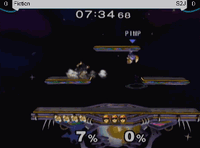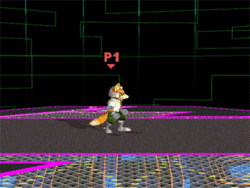Dash-dance
The dash-dance is an advanced technique in the Super Smash Bros. games. Performed by rapidly tapping the analog stick left and right while on the ground, it cancels out the character's initial dashing animation with another animation in the opposite direction, causing the character to quickly and repeatedly dash to the right and left in a short distance.
The time window in which a character can dash then change directions by dash-dancing matches the amount of frames in their initial dash animation. After they complete their initial dashing animation, they'll transition to their standard dashing animation; at this point, tapping the analog stick in the opposite direction will cause the character to enter their turnaround animation, during which no attacks can be performed.
In competitive play
In Super Smash Bros
In the original Super Smash Bros., dash-dancing takes longer to perform, because no matter how fast it is performed, there is a small turnaround animation (except for Captain Falcon) making the maneuver a bit less useful than in Melee. This does however make it a lot easier to Pivot than in Melee.
In Super Smash Bros. Melee

While dash-dancing can be performed in all four games, it derives most of its use in Melee. In Melee, dash-dancing is used primarily to play spacing mindgames with the opponent. By continuously switching directions, the player can confuse opponents in regards to their approach, as they can potentially either backtrack or approach while dash-dancing; in addition, it can also cause opponents to attempt an attack in the dash-forward animation, only for the player to dash backwards and quickly punish the end lag of such attacks by doubling-back. As players can also jump out of a dash-dance, it can allow players to quickly use SHFFLs and wavedashes. Dash-dancing can also be used in conjunction with low-knockback throws to perform tech-chases, as the action allows players to quickly run in either direction, allowing for quick pursuit of rolling opponents. Characters with fast dashing animations, such as Fox, Marth, and Captain Falcon, make the most use of the technique, and proper use of dash-dancing is important in all of their respective metagames.
In Brawl, dash-dancing is more difficult to perform, as the initial dash animation for characters is much shorter than in Melee. In addition, many throws have increased knockback, which, coupled with Brawl's lowered hitstun, makes tech-chasing more difficult. Random tripping also interrupts dash-dancing, leaving the player vulnerable should it occur. As a result of these changes, dash-dancing is considerably less useful than it was in Melee and therefore sees little use in competitive play. The technique, however, is important in Sonic's metagame, as it heavily relies on mindgames and punishment to garner KOs.
In Super Smash Bros. 4, the removal of tripping allows safer dash-dances than in Brawl. However, all initial dash animations are far shorter than they were in Melee, thus making the technique relatively useless and more difficult to pull off in the competitive metagame.

